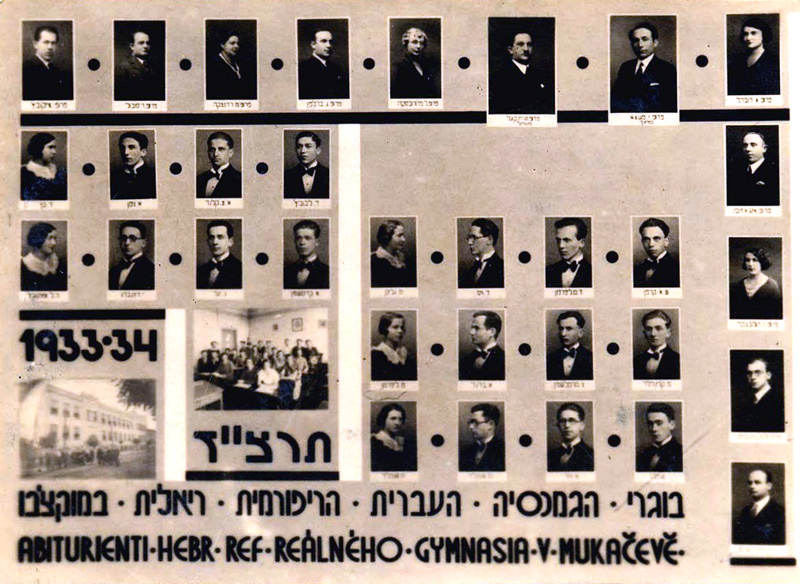A Pledge and a Purpose
In 1934, twenty young men and women, members of the third graduating class of the Munkács Hebrew Gymnasium, signed a unique document in which they promised to meet by the Western Wall in Jerusalem on the eve of Passover 1944. Ten managed to realize this dream and immigrate to Eretz Israel (Mandatory Palestine): A. Brener, Gerson Yägr, Shlomo Karpen (later Arbel), Dov Moshe Liperman (Lipi), Josef Rosenberg, Tzvi (Hrmin) Mermelstein, Aryeh Nemmann, David Weiss (later Livne), Mordechai Josef Schönfeld, and Chana Schönfeld (later Oren).
Download the complete document (PDF)
Read the full text of the document >>>
On 7 April 1944, Passover Eve 5704, the date of the planned reunion in Jerusalem, the Jews of Munkács were facing total annihilation. Immediately after Passover they were imprisoned in ghettos, and on 11 May the deportation trains began leaving from Munkács to Auschwitz-Birkenau.
With the help of former residents of Munkács and materials found in the Yad Vashem Archives, we were able to discover what became of most of the signatories of the "Pledge and Purpose" document.

To identify the people in the photograph, mouse over the images for the names and fates of the teachers and pupils.
The five female signatories were from the third graduating class of the Munkács Hebrew Gymnasium, but only one of them immigrated to Eretz Israel in time. Tova (Gizzela) Liperman, a medical student, was deported on 19 July 1941 to Stanisławów where she was murdered. Rachel Ickovics (Cicu) became a teacher after graduating from the gymnasium and married Oskar Teplinski, a businessman before the war. The couple had one child and they lived in Szanto, Hungary. The family was sent to Auschwitz, and they were all killed. Rachel Katzova became a Hebrew teacher after graduating from the gymnasium. Rachel was sent to Auschwitz and perished. Mädy Glück left Munkács to live in Prague. The name Mädy Glück appears on the list of prisoners at Stutthof. She survived and immigrated to America.
The only one that managed to escape the inferno was Chana Schönfeld. After completing her studies at the gymnasium, Chana became a teacher, and began teaching first grade students at the Hebrew school. In 1938 Chana married Menachem Bergenbaum (later Oren), one of her school teachers, in Munkács. The couple immigrated to Eretz Israel in 1938 on the Apolonia, first living on Kibbutz Tel Yosef, and then on Kibbutz Beit Hashita.
The 15 male signatories were from the third graduating class of the Munkács Hebrew Gymnasium. Aharon Zvi Kellner, single, who became a teacher after graduating from the gymnasium, was murdered on the eastern front while toiling in a forced labor unit. His name appears on the list of victims of "work companies." The fates of David Łebovics, A. Kreitstein, Menachem (Emanuel) Kreindler, and Pavel Weiser remain unknown. However, we know that Kreindler and Kreitstein both left Munkács and were in Prague before the war and Łebovics was in an agricultural training farm in Slovakia in 1940. Additionally, Weiser's name appears on the prisoner lists from Mauthausen.
Nine of the young men managed to fulfill the dreams of their graduating class and immigrate to Eretz Israel. Dov Moshe Liperman, Tova's brother, settled on Kibbutz Ma'anit, where he was both a photographer and an artist; Nemmann was a teacher; Karpen left Munkács under Hungarian rule and reached Prague. He immigrated to Eretz Israel in January 1940 and was a teacher in Be'er Sheva; Rosenberg lived in Afula and became a director of "Tnuva." Brener immigrated to Eretz Israel before the Holocaust and perished at an early age; Yägr was a teacher; Tzvi (Hrmin) Mermelstein was a teacher in Hadera; David Weiss (Livne) was an engineer and an artist; Josef Schönfeld immigrated in 1936 and eventually settled in Haifa, and his older brother Menachem immigrated to England before the Holocaust.
Three of the signatories fulfilled the pledge and met on the eve of Passover 1944 by the Western Wall in Jerusalem: Aharon Brener, Aryeh Nemmann and Gerson Yägr.
Most of the teachers whose pictures appear in the graduating photo of the Munkács Hebrew Gymnasium 1933-34 fared much better. All except one, Eliyahu Rubin, immigrated to Eretz Israel before the outbreak of war. Rubin survived Auschwitz and other camps, and in 1946 he immigrated to Eretz Israel with his wife and son Amos, who had been rescued by József & Margit Strausz, later recognized as Righteous Among the Nations.
Yad Vashem continues its vital mission to retrieve the stories of each and every Holocaust victim, and to commemorate them. If you have any further knowledge of the signatories of the "Pledge and Purpose" document, please contact us.



